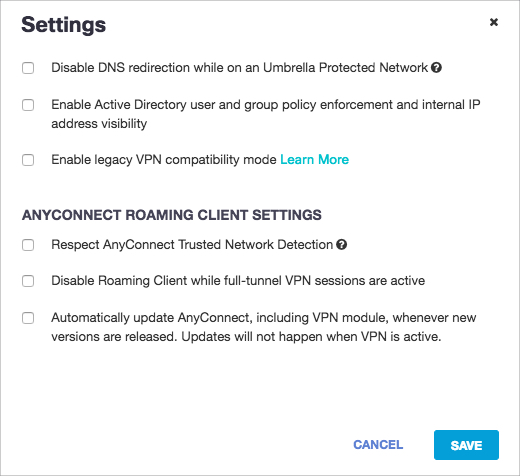

- UMBRELLA ROAMING CLIENT UNINSTALL HOW TO
- UMBRELLA ROAMING CLIENT UNINSTALL INSTALL
- UMBRELLA ROAMING CLIENT UNINSTALL DRIVER
- UMBRELLA ROAMING CLIENT UNINSTALL WINDOWS

Multipass can configure Ubuntu VMs using cloud-init. It can use either Multipass or LXD container as driver. Minikube also has a page that benchmarks the performance of these technologies, where it presents itself as the most performant. Like other Minikube configuration information, Minikube profiles are stored in ~/.minikube under the profile directory. driver, container runtime, cpu, memory, number of nodes, etc) can be stored as a profile with -p switch. When creating cluster, instead of specifying the cluster imperatively, the configuration (e.g. I had to remove dnscrypt-proxy (part of Cisco Umbrella Roaming Client) in order to get minikube to work, as this thread suggests. I noticed a process on my MacBook called dnscrypt-proxy that conflicts with hyperkit DNS server when starting minikube. We can then start a kubernetes cluster, with minikube in a single command.
UMBRELLA ROAMING CLIENT UNINSTALL INSTALL
On MacOS, we first need to install minikube and hyperkit with home brew. As for Docker on WSL2 as driver, Minikube has it as an experimental feature, and requires configuring cgroup to allow setting memory.
UMBRELLA ROAMING CLIENT UNINSTALL DRIVER
If KVM2 driver works it would require nested virtualization so I doubt it will ever be supported. However, WSL2 itself is a VM on top of hypervisor, as explained here.

The kvm2 driver would require a KVM2 hypervisor. The hyperkit driver won’t work (it is designed for MacOS only).
UMBRELLA ROAMING CLIENT UNINSTALL WINDOWS
The Minikube cli command have to be run from Windows PowerShell. On Windows native environment, the preferred driver is hyper-V.Hyperkit can be installed with a home brew command. If you have no other reason to install Docker, then I would recommend hyperkit as the the preferred driver. On MacOS, it lists docker as preferred driver, which would required Docker installed first.In addition to the documents, here some notes from my personal experience: Refer to the document here for preferred driver, and this blog post for more instructions. Depending on your platform (Windows, Linux, or MacOS), the preferred driver is different. This layer of technology (referred to as drivers) makes a big difference. This is typically the use case of a Type II hypervisor, or alternatively, it can also be implemented with container technology. They are separate virtual resources that need to be isolated from computing perspective, and connected as a cluster.
UMBRELLA ROAMING CLIENT UNINSTALL HOW TO
The challenge with running a Kubernetes cluster with multiple nodes locally is how to manage these nodes. These projects are technologies that takes different approach to address the challenges with deploying multiple nodes in local environment (e.g. I will further discuss how to choose among them. The other three: Minikue, MicroK8s and Kind are all certified CNCF project. K3s is accepted as a CNCF project but only at Sandbox maturity level, so it is not my choice. K3s is not straightforward to setup, and k3d is an command-line wrapper to make it easy to install K3s cluster. K3s is Rancher Lab’s lightweight Kubernetes distribution that supports multi-node cluster as well as different runtimes (e.g. This presentation from CNCF covers a lot of details about these technologies. There are a number of alternatives, the most well-known ones are Minikube, MicroK8s, Kind and K3s with K3d. Docker desktop is not a CNCF-certified project anymore, and it is not your choice. If your roles requires deployment, orchestration, automation etc. This essentially renders itself a in-compliant Kubernetes environment.ĭocker desktop still has great value, for application developers who focus on business logics. However, docker desktop still uses docker runtime in it’s single-node Kubernetes cluster. This was announced in December 2020, and is coming through in Kubernetes 1.23, expected Oct 2021. Also deprecated is docker-shim, the temporary interface that had make Docker runtime work in Kubernetes. Now that CRI beats OCI as the standard for container runtime, the docker runtime will no longer be supported by Kubernetes. In the previous post about docker desktop as a single-node Kubernetes cluster setup, I touched on the deprecation of docker-shim.


 0 kommentar(er)
0 kommentar(er)
